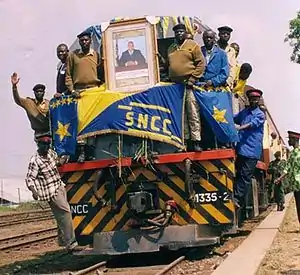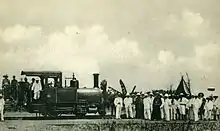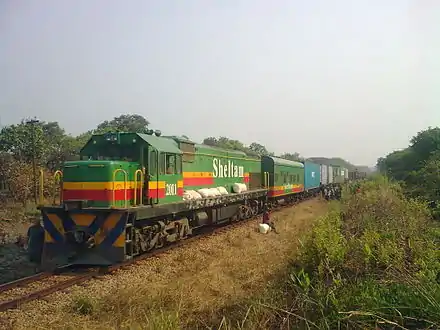Rail transport in the Democratic Republic of the Congo
Rail transport in the Democratic Republic of the Congo is provided by the National Railway Company of the Congo, the ONATRA and the Office of the Uele Railways (Office des Chemins de fer des Ueles, CFU).


The national system is mostly operated by the Société Nationale des Chemins de Fer du Congo, SNCC. Not all rail lines link up, but are generally connected by river transport. The rail systems are listed below.[1][2][3]
Routes
- Matadi-Kinshasa Railway: From Matadi Harbour to Kinshasa via Songolo, Kimpese, Mbanza-Ngungu and Kasangulu, operated by ONATRA, 1,067 mm (3 ft 6 in) gauge, constructed as 765 mm (2 ft 6 1⁄8 in) gauge;[4] three trains a week.[5] In 1928, Congo (Belgium) and Angola (Portugal) did a land exchange to facilitate the new route of the railway to Kinshasa. [6] This line is a bypass of the Livingstone Falls on the Congo River, known as a portage railway. Upstream from the Kinshasa river port, water transport reaches about two-thirds of the country. The line lost traffic to road transport when the Matadi-Kinshasa road was re-established in 2000, and it is now planned to revitalize it with Chinese help.[7] An agreement was signed in July 2006 between ONATRA and a Chinese company (CMIC) which will renovate the track, trains, telecommunications, signal system and electric supply. The line reopened in September 2015 after around a decade without regular service. As of April 2016 there was one passenger trip per week along the line and more frequent service was planned.[8]
- Vicicongo line: Bumba (Congo river port) - Aketi - Buta - Likati - Isiro - Mungbere, with branch lines to Bondo and Titule; 600 mm (1 ft 11 5⁄8 in) narrow gauge. The line was opened by Chemins de Fer Vicicongo in 1923 and is 1235 km (741 mi) long.[9]
- Great lakes line first section: Kisangani (Congo River port) to Ubundu (upper Congo River port), 1,000 mm (3 ft 3 3⁄8 in).[10] This line is a bypass (portage railway) of the Stanley Falls on the Congo River. A train runs after arrival at Kisangani of a ship from Kinshasa or before departure of a ship to Kinshasa, which may happen about every 2 to 3 month, no fixed schedule. There is no connecting boat service between Ubundu and Kindu on the Lualaba River (the upper Congo).[11]
- Great lakes line second section: Kindu (Lualaba River port) - Kibombo – Kongolo – Kabalo (Lualaba River port and junction with Katanga line) - Nyunzu – Niemba – Kalemie (the port on Lake Tanganyika), 1,067 mm (3 ft 6 in). This line was 1,000 mm (3 ft 3 3⁄8 in) gauge like the first section until 1955, when the gauge was changed for the connection with the Katanga line in 1956. Just north of Kongolo, the Lualaba is unnavigable due to the rapids named Portes D'Enfer ('Gates of Hell'). The track between Kalemie and Niemba is described by UNJLC in 2006 as 'very degraded' and may not be operational. Boats to Moba and Kalundu-Uvira on Lake Tanganyika used to connect with trains at Kalemie. In 1917 a train ferry was introduced on the lake operating from Kalemie, but is long gone.
- Katanga line: Kabalo (Lualaba River port and junction with Great Lakes line) – Kamungu - Katumba – Kabongo (or a town 8 km south-east) – Kamina (junction with Kasia line) - Bukama (Lualaba River port) – Tenke (junction with Benguela Railway) - Likasi – Lubumbashi - Sakania - Zambia, 1,067 mm (3 ft 6 in). There are a number of short branch lines in the mining areas between Tenke and Kolwezi. The section from near Kabongo to Kamina was described by UNJLC in 2006 as 'very degraded'. Kamina - Lubumbashi section will be straighter, fully grade-separated route to use 1,520 mm (4 ft 11 27⁄32 in) track gauge in July 2019 and fully electrified with minimum overhead wiring height at 6.75m above top of the rails. However, this will make break-of-gauge (1520mm/1435mm) creation at several junctions (to Kenya, to Mozambique, and to Angola) and northern border region.
- Kasai line: Ilebo (Kasai River port) – Kananga – Mwene Ditu – Kaniama - Kamina (junction with Katanga line), 1,067 mm (3 ft 6 in). This connects the Katanga line to the river port at Ilebo from where boats can reach Kinshasa. Freight is transferred to river barges, but in 2006 UNJLC reports the river service operates sporadically. On 1 August 2007 a passenger train ran out of control on the line 170 km north-west of Kananga and 7 coaches overturned, killing about 100 people.
- Katanga-Benguela line: A branch of the Katanga Railway was built from Tenke junction just north-west of Likasi via Kolwezi to Dilolo at the Angolan border to connect with the Benguela Railway 1,067 mm (3 ft 6 in) from Luau to the Atlantic port of Lobito. This allowed through passenger trains to run between Lubumbashi and Lobito, and freight trains to carry copper from the Zambian and Katangan Copperbelts to a seaport for the export of copper. It was this purpose which provided the investment for the Benguela Railway. It did not operate through Angola from the 1970s, due to the civil war there. The line between Kolwezi and Dilolo was described by UNJLC in 2006 as 'very degraded'. It reopened in 2018.[12]
The following lines have been completely removed and are not listed for future rehabilitation:
- Mayumbe line: Boma to Tshela, 1889–1984, 610 mm (2 ft) gauge,[4] 137 km long and opened in stages from 1901 to 1913.[9] removed in 1984.[13]
- Kivu Railway: Kalundu-Uvira-Kamaniola (- Bukavu), 1931–1958, 1,067 mm (3 ft 6 in).[14]
- Forminière railway 1923-1955 600 mm (1 ft 11 5⁄8 in) Followed the river Kasai from Charlesville to Makumbi.[15]
Track totals
4772 km (2002), 5138 km (1995);
narrow gauge:
- 3621 km 1,067 mm (3 ft 6 in) gauge (858 km electrified); (2002)
- 3987 km 1,067 mm (3 ft 6 in) gauge (858 km electrified); (1996)
- 125 km 1,000 mm (3 ft 3 3⁄8 in) gauge; (2002) ev. transformed to 1,067 mm (3 ft 6 in) gauge in 1955[16]
- 1026 km 600 mm (1 ft 11 5⁄8 in) gauge (2002);
Railway links to adjacent countries
There is only one currently functioning international link:
- Zambia - yes - same gauge - 1,067 mm (3 ft 6 in), connects with railways of Zimbabwe, Mozambique and South Africa.
This link is currently not operating:
- Angola - yes - same gauge - 1,067 mm (3 ft 6 in). The link to the ports of Benguela and Lobito was unusable from the 1970s, but has been rehabilitated. The Angolan transport minister Augusto Tomás promised the reconstruction up to the border station at Luau in Moxico province by the end of 2012. The focus was then be on the line from Dilolo to Kolwezi. The line reopened in 2018.[12]
- In 2012, Angola started plans for a line from Luanda via the Matadi Bridge to the enclave of Cabinda province which necessarily crosses Congo territory, with a junction with Congo's Matadi-Kinshasa Railway.
There are boat links to rail lines in these neighbouring countries:
- Republic of Congo - no direct link, but ordinary ferries across the Congo River from Kinshasa to Brazzaville can take passengers and freight to the Congo-Ocean Railway (same gauge 1,067 mm (3 ft 6 in)) which runs from Brazzaville to the Atlantic port of Pointe Noire.
- Tanzania - no direct link but boats take freight between Kalemie and Kigoma, from where Tanzania's Central Line runs to the seaport of Dar es Salaam; there once was a train ferry from Kalemie built in 1917; break of gauge 1,067 mm (3 ft 6 in)/1,000 mm (3 ft 3 3⁄8 in).
These neighbouring countries have rail systems, but there are no links from the Congo:
- South Sudan - no - same gauge 1,067 mm (3 ft 6 in)
- Uganda - no - break of gauge 1,067 mm (3 ft 6 in)/1,000 mm (3 ft 3 3⁄8 in).
These neighbouring countries have no rail systems: Central African Republic, Rwanda and Burundi.
Proposed rail projects
- In September 2007 it was reported that China would provide US$5 billion for new infrastructure projects including rehabilitation and construction of new sections to link Sakania and Lubumbashi to Matadi (3200 km), to be completed in 3 years.[17]
- A line from Uganda to Kasese was proposed in 2005.[18]
- In 2012, a new or rehabilitated 1,435 mm (4 ft 8 1⁄2 in) gauge line was proposed from Kisangani to the port of Lamu in Kenya.[19]
- In 2019, the SNCC reached a $500 million agreement with Russian Railways for the company to help upgrade the DRC's railway system.[20]
Criticism
The rail network in the Democratic Republic of the Congo has experienced numerous accidents due to poor maintenance. The death toll is frequently high, partly due to the practice of train surfing. A major accident in August 2007 lead to the deaths of over 100 people at Benaleka, Kasai-Occidental. In April 2014, 48 people were killed and 160 injured when an SNCC train derailed near Katongola, Katanga Province. 33 were killed in a further incident in November 2017 near Lubudi, Lualaba Province.[21] 32 were killed in an accident in Kasai Province in March 2019.[22] In September 2019 at least 50 persons died as a result of a derailment in Tanganyika.[23]
Locomotives
On 3 November 2008, four diesel-electric locomotives were supplied to the DRC from China. These are 1,800 hp Co-Co locomotives, model CKD7C, built by the CRN Dalian.[24]
Gallery
 Steam locomotive of 1898
Steam locomotive of 1898 Ex-SAR 33-200 locomotive (33-219) now owned by Sheltam and doing duty in DRC Congo for SNCC
Ex-SAR 33-200 locomotive (33-219) now owned by Sheltam and doing duty in DRC Congo for SNCC
Maps
Stations served by rail
See also
References
Notes
- Railways in Southern Africa. This source does not distinguish between operational and non-functioning lines.
- UNJLC Map number: UNJLC DRC 001 (7 MB) Archived 2007-07-24 at Archive.today. This source distinguishes between 'operational' and 'very degraded' lines, but detail on some sections is obscured by roads.
- Rail Network Description at UNJLC. Archived 2007-07-24 at Archive.today Retrieved 2 June 2007.
- "Standard steam locomotives". orion.math.iastate.edu. Retrieved 2017-07-12.
- "DRCongo_Matadi". www.fahrplancenter.com. Retrieved 2017-07-12.
- [Railways Africa 2014 issue 5, p29]
- Le Potentiel, 16 August 2006.
- "Plus de 13 000 passagers transportés par train entre Kinshasa et Matadi" (in French). Radio Okapi. 10 April 2016. Retrieved 16 April 2017.
- Durrant, A.E., A.A. Jorgensen, C.P. Lewis. Steam in Africa, London, 1981, Hamlyn.
- www.bck-kdl.be/Ligne Stanleyville-Ponthierville Archived 2007-09-27 at the Wayback Machine
- "DRCongo_Ubundu". www.fahrplancenter.com. Retrieved 2017-07-12.
- "O sonho de muitos angolanos tornou-se realidade – CAMINHO DE FERRO DE BENGUELA – E.P." (in Portuguese). Retrieved 2019-08-09.
- Closed "owing to its lack of profitability" (Inter Rail No. 2/1997); Mobutu also closed the bank branches and industry in this region (Le Potentiel No. 3700/2006).
- Blanchart, Charles: Le Rail au Congo Belge 1920–1945. Bruxelles: Blanchart, 1999
- "Openstreetmap". Retrieved 2020-04-12.
- www.bck-kdl.be Archived 2007-09-27 at the Wayback Machine
- "China Invests In DRC Transport Infrastructure." OT Africa Line website, dated 17/9/07, source AFP.
- "African projects deserve support". Railway Gazette International September 2005
- "Archived copy". Archived from the original on 2012-11-19. Retrieved 2012-11-19.CS1 maint: archived copy as title (link)
- Kavanagh, Michael (26 October 2019). Russian Railways, DR Congo to Discuss Possible $500m Rail Deal. Bloomberg.
- Akwei, Ismail (13 November 2017). "At least 33 killed in the Democratic Republic of Congo freight train crash". Africa News. Retrieved 18 March 2019.
- Rahman Alfa Shaban, Abdur (18 March 2019). "About 32 killed as train derails in DRC's Kasai region". Africa News. Retrieved 18 March 2019.
- https://www.reuters.com/article/us-congo-accident-idUSKCN1VX19T
- "Archived copy". Archived from the original on 2012-09-08. Retrieved 2009-09-05.CS1 maint: archived copy as title (link)
Further reading
- Robinson, Neil (2009). World Rail Atlas and Historical Summary. Volume 7: North, East and Central Africa. Barnsley, UK: World Rail Atlas Ltd. ISBN 978-954-92184-3-5.
- Le rail au Congo belge (3 vols. 1993–1999)
- Nicolaï, H.; Jacques, J. (1954). La transformation des paysages congolais par le chemin de fer. L'exemple du B.C.K. (PDF). Brussels: Institut Royal Colonial Belge.
External links
![]() Media related to Rail transport in the Democratic Republic of the Congo at Wikimedia Commons
Media related to Rail transport in the Democratic Republic of the Congo at Wikimedia Commons